For any person, surgery is a serious step. The postoperative period that follows is no less complex and dangerous. Sometimes it lasts for a long time. If the stitch hurts for a long period after surgery, you need to see a doctor.
Causes of pain
Unpleasant sensations and pain at the suture site can occur after any surgical intervention. The nerve fibers of the soft tissues are damaged, and the sensitivity of the injured part of the body increases. This process is natural and understandable - damaged tissues grow together, sutures heal.
But if over time the pain only intensifies, and the temperature periodically rises, this is a reason to seek help. Internal tissue suppuration may occur even if the external incision is closed.

Why does the suture hurt after surgery and how long will it take to heal? This directly depends on the complexity and duration of the operation, the qualifications of the surgeon, and the cleanliness of the instruments and materials used. Pain may occur for the following reasons:
- the seam area has been rubbed by clothing;
- formation of adhesions, hernias;
- inflammation at the site of the ligature - the body rejects the threads;
- divergence of internal seams due to muscle tension;
- aching pain, as a reaction to a sudden change in weather conditions.
Duration of pain
How long can a stitch hurt? Unpleasant sensations can be constant or occur periodically, for example, with muscle tension, coughing, sneezing. Pain and swelling around the wound may be accompanied by other symptoms. The stitches may leak fluid or pus. Characterized by general weakness and lethargy, sleep and appetite disturbances, decreased concentration.
It is impossible to say exactly how long the stitch will hurt after surgery. Everyone's deadlines are different. Typically, pain in the suture area lasts a little more than a week, depending on the characteristics of the body. The average healing time for surgical wounds depends on their location: 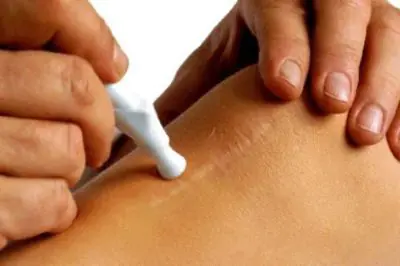
- for wounds from abdominal surgery - about two weeks;
- sutures after appendicitis and laparoscopy are tightened after 7 days;
- circumcision involves a regeneration period of up to 15 days;
- The sutures in the chest area take a long time to heal;
- healing of the postpartum suture occurs within 10 days;
- external sutures after cesarean section are removed on the 6th day.
Seams can be internal and external. The first ones are applied using catgut made from sheep intestines. They dissolve independently in the body. The outer ones are more durable, they are made with natural (silk, linen) or synthetic threads. After a certain time, such sutures are removed. Metal staples are also used. It should be understood that the connective tissue fully grows within 2-3 months.
Painful stitches after cesarean section
After the intervention, the wound is present on the skin, fatty tissue, muscles, and uterine wall. Often women complain that the suture hurts after a cesarean section. Pain makes it difficult for a woman to recover and care for her baby.
The pain is sharp, does not subside, lasts two days, is relieved with medications. It gradually decreases, discomfort and itching can be observed for about two weeks. The sensitivity of the skin is impaired, and numbness of the abdomen in the area of the incision may occur. Symptoms disappear completely within six months. Regular inspection of the condition of the seam by a specialist is necessary.
When the suture hurts after a cesarean section for a long time, or complications arise - suture dehiscence, swelling, redness, fever, purulent discharge - a visit to the doctor is required. Sometimes the consequences take a long time to make themselves felt. In a few years, fistulas may form from the suture material. The scar thickens, its color changes, and the fistulas periodically fester.
Features of seam care
Restoration of the skin and healing of sutures depends on the body’s immunity and the skin’s ability to regenerate. After laparoscopy, small incisions remain; they are not sutured, but glued together with adhesive tape. A postoperative scar can be large, have drainage, take a long time to heal, and require high-quality care.
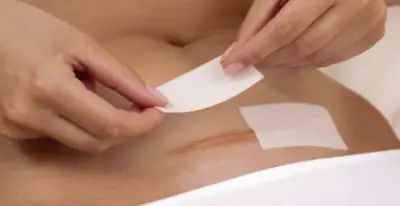
Treatment of the wound in a hospital is carried out by medical staff. After discharge, the patient takes care of the suture at home, in accordance with the doctor’s recommendations. In order for the seam to tighten quickly and well, you need to:
- follow doctor's orders;
- maintain personal hygiene;
- adequate sleep is necessary;
- proper nutrition.
For the first 10 days it is not recommended to take a bath; you can wash in the shower. The scar is carefully dried with a bandage, then treated with an antiseptic. Iodine, brilliant green, Fukortsin, alcohol and others are suitable. You should not use cotton wool for processing, as fibers may remain on the seams. A prolonged seam can be lubricated with sea buckthorn oil or Levomekol ointment. If the wound is clean and dry, a bandage is not needed.
Circumcision is the most frequently performed procedure by urologists. After the operation, the patient independently makes dressings with Furacilin solution at home. Before removing, the bandage must be soaked in hydrogen peroxide so as not to injure the wounds. When the bandage is easily removed, the dressings are stopped. The wounds can be lubricated with brilliant green or antiseptic ointment applied. To avoid complications and pain in postoperative sutures, circumcision should be performed by an experienced and qualified urologist.
How to get rid of pain
After any violation of the integrity of the skin, scars form. Sometimes they cause not only physical pain, but also emotional discomfort, being a cosmetic defect. In the affected area, connective tissue cannot replace healthy skin, since it does not have sebaceous and sweat glands. Changes also occur in the nerve endings located in the skin. Painful formations – neuromas – appear in the thickness of the suture.
Neuropathic pain syndrome occurs. Pain occurs not only in the scar, but also around it. It can be burning, shooting, and can get worse after coughing or sneezing. In addition to analgesics, hormonal drugs and antidepressants are used. Patients do not tolerate physiotherapeutic procedures well, since the suture is very sensitive to touch. If drug therapy does not have an effect, the scars are removed surgically.
Over time, the seam fades and becomes less noticeable. To restore skin, food must contain enough protein, vitamins and microelements. In summer, the seam should be protected from sunlight; thin, delicate skin can get burned. There are drugs in pharmacies that promote the resorption of sutures. The scars can be massaged daily, while rubbing in vitamin E or “Star” balm.
Scars remain from any surgical intervention - these are the former sutures at the site of the incision of the skin and subcutaneous tissue. Typically, a medicinal ointment is used to heal sutures after surgery in order to soften and anesthetize the suture area and accelerate the regeneration of the epidermis. The ointment prevents the spread of infection, stops inflammation and promotes rapid and painless healing of wound edges.
The healing process of postoperative sutures
Postoperative scars are formed depending on the nature of the injury, method of operation, suture material and other factors, but there are several main types:
- normotrophic scar - a common type of scarring, which is obtained as a result of not very deep surgical intervention; such scars are hardly noticeable and almost do not differ in shade from the surrounding skin;
- atrophic scar – remains after acne, boils, excision of papillomas and moles; the surface of such a scar is a bit like a dent in the skin;
- hypertrophic scar - occurs if suppuration occurs or the sutures have undergone traumatic divergence;
- keloid scar – forms on the skin after deep surgery or in case of slow healing without sufficient blood supply; protrudes slightly above the skin level, has a white or pinkish color and a smooth texture.
First, the collagen layer is restored, which promotes tissue fusion, strengthens scars and prevents the appearance of skin defects. Then an epithelial layer spreads over the surface of the wound, which protects the damaged tissue and does not stop the penetration of pathogenic microorganisms. After 5-6 days, the suture edges grow together, the surface is gradually covered with new skin.
Under normal conditions, with regular treatment, when ointment is used for sutures after surgery, the wound surface heals within a few days, depending on the location on the body:
- on the face, on the head – from 3 to 5 days;
- on the chest and abdomen - from 7 to 12 days;
- on the back – from 10 days;
- on arms, legs – from 5 to 7 days.
When asked what to apply to a postoperative suture, you must first treat it with antiseptic agents to prevent inflammation and suppuration in the wound cavity. For this use:
- hydrogen peroxide,
- dimexide,
- miramistin,
- chlorhexidine,
- furatsilin,
- alcohol solution of iodine, brilliant green and other means.
So, is it possible to smear brilliant green on the seam after surgery? – you can, but all alcohol products cause discomfort, burning and tingling, it is better to use milder options.
Important! You cannot peel off the crusts and growths that appear on top of the seam if it does not bother you, does not hurt, or is inflamed. This is a natural process of tissue fusion, and unnecessary damage can lead to improper formation of a scar.
Basic rules of care and advice on what to apply to the suture after surgery will help restore the skin faster:
- cleaning and treatment of seams should occur 2-3 times daily;
- all manipulations are performed with sterile gloves or hands treated with a special disinfectant;
- if the wound is wet, traces of inflammation are noticeable, the edges move apart, you need to wash it with an antiseptic;
- if the wound is dry - painless, covered with a crust, then healing ointments can be applied.
Healing ointments for treating sutures
Emollient, anti-inflammatory ointments for healing postoperative sutures have a local superficial effect and do not affect the general condition of the body, so they can be used immediately after surgery. They soften dried edges, accelerate regeneration and eliminate infection of the wound by various microbes. Therefore, healing occurs faster and the scar is formed more evenly.
Depending on how deep the penetration of the wound is, different types of ointments are used to resolve postoperative sutures: for healing and softening of superficial sutures and for treating deep injuries, when ointments with hormonal components are used.
When treating a suture, the depth of the wound, the degree of healing and the side effects of drugs are taken into account:
- the gel product is applied to wet, open wounds, while the active components quickly reach the damaged areas;
- ointment for healing postoperative sutures - it is better to use for dried sutures at the stage of fusion of the skin edges, since ointments contain fatty substances that create an invisible film and slow down healing.
The most effective wound-healing drugs that are prescribed to lubricate sutures after surgery:
- Baneocin - in powder or ointment form, contains bactericidal antibiotics bacitracin and neomycin, which stop the spread of infection. The powder solution is recommended to be used to treat the wound in the first 2-3 days, then Baneocin ointment can be used. Analogues: Sintomycin, Fusiderm.
- Actovegin is available in the form of an eye gel and as an ointment. Contains components of the blood of calves, improves trophism and tissue regeneration. Analogs: Algofin, Kurantil.
- Solcoseryl - in the form of ophthalmic gel, dental adhesive paste, external gel and ointment. It also contains calf blood extract, but the cost is higher than Actovegin. Solcoseryl gel is applied to fresh, unhealed wounds, to wet, non-healing tissue. Solcoseryl ointment is used after epithelization of the wound surface, for further healing of dried sutures, and promotes the formation of smooth, elastic scars.
- Levomekol is a traditional drug with local antibiotics, widely used in home and hospital settings, and is available to almost every patient. This combination drug has anti-inflammatory (dehydrating) and antimicrobial effects. Active against gram-positive and gram-negative microorganisms (staphylococci, Pseudomonas aeruginosa and Escherichia coli). Penetrates without damaging biological membranes and stimulates regeneration processes. Contains chloramphenicol, methyluracil and auxiliary substances, effective in purulent and necrotic processes. Analogues: Levomethyl, Levomycetin, Chloramphenicol.
- Methyluracil is a drug with a regenerating and anti-inflammatory effect, used to accelerate the regeneration process during sluggish epithelization of wounds and burns. Analogs: Bepanten.
- Eplan is a universal, effective remedy for the treatment of burns, cuts, and surgical sutures. It has an analgesic and disinfecting effect, promotes rapid restoration of damaged tissues. The ointment contains: glycolan, ethylcarbitol, triethylene glycol. Analogues: Kvotlan.
- Naftaderm is a drug with a disinfectant, wound-healing and antipruritic effect, promotes rapid healing and uniform resorption of scars. Active ingredient: refined naftalan oil. This cream for sutures after surgery is also used to treat dermatitis and bedsores.
- Vulnuzan is a cream for healing sutures after surgery based on natural ingredients, active ingredient: mother liquor of Lake Pomorie. It has antibacterial, anti-inflammatory properties, improves the regeneration of damaged tissues.
- Mederma is a scar smoothing gel used to smooth out scar tissue a month or two after healing. Analogues: Contractubex is an effective modern cream for resorption of postoperative sutures.
Additional recommendations in the postoperative period
For a speedy recovery and healing of sutures, it is necessary to follow the basic rules of hygiene and treatment regimen:
- regularly wash and treat the damaged area;
- follow all instructions and recommendations of a specialist, what to apply to the sutures after surgery;
- carefully study the instructions for medications and do not use ointment for postoperative sutures if there are the described contraindications;
- allow only feasible physical activity to avoid traumatic effects and seam divergence;
- follow a diet and medical prescriptions regarding nutrition and weight regulation.
By following these simple recommendations on what to apply to a postoperative suture for quick healing, you can significantly speed up your recovery and return to your usual activities. Even minor damage to the skin can lead to inflammation and infection. In order to leave smooth, unnoticeable scars, it is necessary to promptly treat surgical sutures with medicinal ointments.
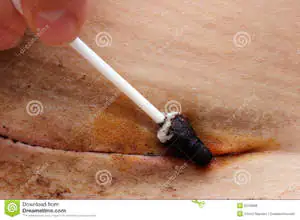
Skin scars are an inevitable consequence of any open wound or injury. In most cases surgical intervention leaves behind postoperative stitches. The healing of these scars is facilitated by prevention after surgery: the surgeon should give recommendations that will make the postoperative scar almost invisible.
Main types of postoperative sutures
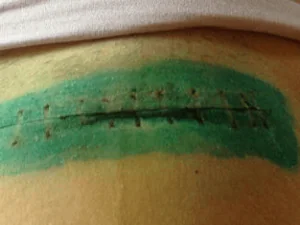
Any surgical intervention leaves behind a scar. The more complex the operation, the deeper the scar remains and the slower the healing process. In addition, the physiological characteristics of the human body play a huge role, in particular the supply of the skin with the necessary amount of blood.
Correct scar care allows the wound to heal faster and more gently, leaving minimal damage. Caring for postoperative sutures is necessary so that they tighten well and do not give the person any unpleasant sensations. Postoperative scars are divided into several main types:
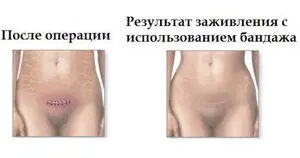
Normotrophic scar. This type of scar is considered the simplest. It forms in most cases after shallow surgical interventions. As a rule, this scar has not too noticeable defects and has the same shade as the surrounding skin tissue.- Atrophic scar. Formed when moles or warts are removed. The tissue of this type of scar slightly dominates the formation itself and looks like a hole.
- Hypertrophic scar. It is formed when suppuration appears or as a result of trauma. To avoid such a scar, it is necessary to care for the wound with ointment to heal the sutures after surgery.
- Keloid scar. This scar is formed on the skin, which is poorly nourished by blood, and in the case of deep surgical intervention. This scar has a pinkish or white color, protruding above the basic level of the skin. Sometimes it gives off shine.
Treatment of scars at home
In order for postoperative scars to heal easily and quickly, without leaving behind painful complications, they must be properly cared for. You should know how to treat a postoperative suture for better healing. Basic care involves treatment with an antiseptic. The simplest means for processing:
- Zelenka, which is a disinfectant and antibacterial agent.
- Alcohol can remove any contaminants and kill all pathogenic bacteria.
- Thanks to iodine, healing can be accelerated.
You can use special products designed to speed up the healing of postoperative scars. These include:
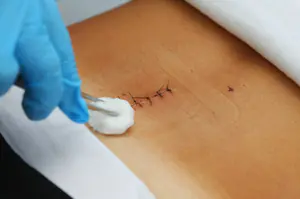
Fukortsin. With its help, high-quality treatment of the skin is carried out, providing proper care for postoperative scars.- Levomekol ointment. Accelerates the healing process, nourishes the skin.
- Ointments with panthenol - helps tighten scars.
- Contractubex or Mederma. Used in the second or third month after surgery to smooth out the skin and tighten the stitches.
- Sea buckthorn and milk thistle oil. Nourishes the skin, heals wounds and promotes smoother tightening of postoperative sutures.
The seal on the seam is normal reaction. When the scar has become hard, it is necessary to continue treating the sutures with the means described above until complete healing.
Self-removal of stitches
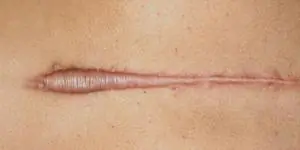
Sometimes postoperative sutures can be removed independently at home, but subject to the doctor's permission. You need to know that there are two main types of seams.
Immersion - applied with thread, made of natural materials. Its advantages are that the material is independently absorbed by the human body and is not rejected. The disadvantage is that it is less durable. Removable - removed only when the edges of the incision are fused and are able to show how well the healing is proceeding. It is applied using silk, nylon, nylon, wire thread, and also a staple.
When removing threads at home, it is also necessary to take into account the timing after the operation. The approximate timing of suture removal after surgery will be as follows:
- From 1 to 2 weeks - for head surgery.
- From 2 to 3 weeks - in case of amputation.
- About 2 weeks - when opening the abdominal wall. In this case, the period will depend on the depth of penetration.
- From 1.5 to 2 weeks - on the chest.
- 2.5 weeks - for stitches in an elderly person.
- From 5 days to 2 weeks - after childbirth.
- From 1 to 2 weeks - for caesarean section.
As mentioned earlier, stitches can be removed at home on your own. Some rules must be followed:

It is necessary to remove postoperative sutures carefully and carefully, remaining calm - only in the absence of an inflammatory process.- To remove stitches, you will need two tools: tweezers and nail scissors. Before the process itself, the instruments must be thoroughly treated with alcohol.
- Before work, wash your hands thoroughly with soap and water twice and put on medical gloves. You can treat your hands with an antiseptic.
- All manipulations must be carried out under a bright lamp in order to carefully see the entire process.
- Next, the seams are cut and the maximum number of threads is removed. The edges of the protruding threads need to be picked up with tweezers and gently pulled until the piece comes out of the skin.
- When absolutely all the pieces are pulled out, treat the wound with antiseptic ointment with antibiotics.
You need to have sterile bandages and tissues and a furatsilin solution with you - for the safety of the suture removal process, so that infection does not get inside.
Preparations for healing and resorption
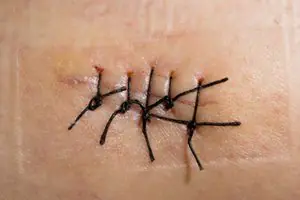
At any pharmacy you can purchase a product to care for scars after surgery. Among them, ointments for resolving sutures are especially popular. The principle of their action is to relieve inflammation, smooth out the scar with the skin, eliminate healing defects, give the scar a light shade and nourish the skin, making it smooth and elastic.
Basically, such products and ointments are created on the basis of silicone, with which you can get rid of the itching that inevitably occurs. during wound healing. Regular care of the seam helps it shrink and become less noticeable. The substances are applied in a thin layer, but their application may be ineffective. In such situations, at least six months of active use of the ointment is required. The most effective ointments for these purposes are:
- Contractubex gel smoothes the skin, accelerates cell regeneration and improves blood circulation.
- Mederma gel - resolves scar tissue, improving it through blood supply and hydration.
You can also use other means that speed up the resorption of sutures. Such medicines often contain onion extract. It is this component that is able to penetrate deeply into tissues, providing an anti-inflammatory and soothing effect.
It is necessary to choose a gel or ointment for caring for a scar based on its depth and scale. The most popular ointments are antiseptic. Such means include:
- Vishnevsky ointment. This classic healing agent has powerful tightening properties and removes pus from wounds if the suture does not heal after surgery, and the patient does not know what to do.
- Vulnuzan is a healing ointment made from natural ingredients.
- Levosin is an ointment with powerful anti-inflammatory and antibacterial effects.
- Eplan - has healing and antibacterial effects.
- Actovegin - can improve healing, relieve inflammation and improve blood supply to tissues. It is recommended to use if the scar has festered and turned red.
- Naftaderm relieves pain well and improves the resorption of scars.
In addition, there is another new generation product that effectively combats postoperative sutures: special patch, which must be applied to the suture site after surgery. The patch is a plate that fastens the incision site and nourishes the wounds with the necessary nutrients. The main beneficial properties of this patch:
- Made from a material that absorbs discharge from wounds.
- Does not allow pathogenic bacteria to enter wounds.
- Does not irritate the skin.
- Nourishes the wound with air.
- Allows the seam to be smooth and soft.
- Does not allow the resulting scar to grow.
- Together, the scar retains the necessary moisture.
- It is comfortable to use without injuring the wound.
The use of folk remedies
To improve the condition of the skin, smoothing seams and reducing scars, it is necessary to act on problem areas in a comprehensive manner, using medications and folk recipes. In this case, the following folk remedies can help:
- Essential oils. The oil or mixture of oils will help speed up the healing of the scar by nourishing the skin and removing the effects of healing.
- Seeds of melons - for example, pumpkin, melon, watermelon. They are rich in essential oils and antioxidants. You need to make a paste from fresh seeds of these plants, apply it as a compress to the affected areas of the body.
- Compress made of milk and pea flour. From these ingredients you need to make a dough, which is applied to the damaged areas and kept there for at least 1 hour. The resulting composition tightens the skin well.
- Cabbage leaf is considered an old but very effective remedy. If you apply a cabbage leaf to a wound, it has a healing and anti-inflammatory effect.
- Beeswax can nourish the skin well at the scar site, relieving inflammation, swelling, and smoothing the skin.
- Sesame or olive oil well moisturizes and nourishes the skin, brightens, smoothes and tightens scars.
What to do if the seam comes apart
Sutures may come apart after surgery for several reasons. Most often this happens due to the following reasons:
- The wound became infected.
- The man's blood pressure has risen.
- There is a disease in the body that makes the tissues soft.
- The stitches are too tight.
- The scar is injured.
- The person is over 60 years old.
- The patient has diabetes.
- There are kidney diseases.
- The person is overweight or has a poor diet.
- There are bad habits.
In this case, you must urgently consult a doctor who will prescribe treatment based on blood tests. The specialist can apply postoperative bandage, and the patient will be monitored more carefully.
Under no circumstances should you try to heal a wound on your own if the stitches have come apart. In case of incorrect actions, the patient risks getting more serious complications - for example, blood poisoning.
In most cases, postoperative scars are very itchy. Itching is normal reaction to fastening threads, as they irritate the skin. If dirt gets into the wound, this is how the body resists germs. The stitch may itch because the wound is healing, tightening and drying the skin. When healing a scar, you should not scratch the tissue, because this action will not bring any pleasant sensations or relief, and can only aggravate the situation.



